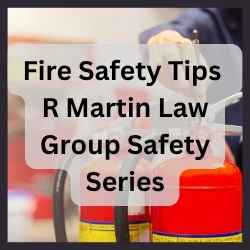
As the Pacific Northwest awakens each spring and summer, Washington’s breathtaking beaches, lakes, and rivers draw locals and visitors seeking sun, scenery, and adventure. But before you dip your toes into those glistening waters, there’s one crucial topic you can’t afford to ignore: Water Safety Tips. Understanding the unique hazards of Washington’s waterways—and learning season-specific strategies to stay safe—can turn a day of relaxation into a cherished memory rather than a tragedy.
At R Martin Law Group, our personal injury expertise means we’ve seen first-hand how quickly things can go wrong when water precautions are overlooked. With decades of hard-won courtroom experience, Attorney Rich Martin stands at the ready to help—but we’d much rather you and your loved ones never need us at all! Read on as we share professional, practical water safety insights tailored to every season in Washington State.
Why Focus on Water Safety in Washington State?
From the chilly shores of Puget Sound to the roaring Columbia River and serene Alpine lakes, Washington’s waterways are as diverse as they are beautiful—and often, more hazardous than you’d think. Whether you’re planning a solo paddle, a family beach picnic, or a group boating adventure, mastering the art of water safety is non-negotiable.
This comprehensive guide will spell out the crucial Water Safety Tips for every season, address frequent family concerns, and show you how to successfully navigate potential perils like cold shock, rip currents, and unpredictable weather. Let’s jump right in!
Spring Secrets: How to Stay Safe While Swimming in Cold Washington Waters
If you imagine that spring sunshine means toasty lake swims, think again! Washington waters remain icy well into late spring (and sometimes beyond), presenting a host of dangers even to seasoned swimmers. Wondering how to stay safe while swimming in cold Washington waters during spring? Here’s the insider scoop:
1. Understand Cold Water Risks
- Cold Shock: Sudden immersion in 50–60°F water can trigger involuntary gasping, panic, and rapid incapacitation—even if the sun is blazing above.
- Hypothermia: Water steals heat from the body 25 times faster than air, and even brief exposure can prove deadly. Young children and non-swimmers are at highest risk.
2. Scout the Scene for Hidden Dangers
- Fast Currents: Melting snow turns rivers and waterfalls swift and unpredictable.
- Debris and Obstructions: Spring runoff washes logs and rocks into play.
- Watch the Weather: Storms move in fast; always check forecasts.
3. Life Jackets: Non-Negotiable Gear
- Make it a law in your household to wear a Coast Guard-approved life jacket anytime you step near open water, especially for kids.
- Why are life jackets essential for children near Washington lakes and rivers? Because even brief cold water exposure can sap strength and mobility quicker than you’d ever imagine.
4. Keep Kids within Arm’s Reach
- Vigilant, undistracted adult supervision is mission-critical! Cold water can immobilize a child in seconds.
5. Avoid Fast-Moving Streams and Merging Rivers
- Never underestimate the force of moving water, especially where two currents meet. When in doubt, stay out!
Pro Tip: Want more insights on how to stay safe in cold spring waters? The Washington Department of Health updates their water safety guidelines every year.
Summer Smarts: Best Beach Safety Practices for Families in Washington State
Summer is when most families flock to the water—but the warmer temps can create a false sense of security. What are the best beach safety practices for families in Washington State? Stack the deck in your favor with these expert-tested precautions:
1. Watch Out for Sneaky Dangers
- Hidden Cold Beneath the Surface: The top few inches of water may warm up, but deeper layers remain bone-chilling, ready to sap your energy in minutes.
- Rip Currents: Fast-moving channels of water can carry even Olympic swimmers away. (More on spotting and surviving them below!)
2. Always Swim in Designated Areas
- Choose beaches with lifeguards when possible.
- Avoid unsupervised or non-designated swim zones, especially with children.
3. Use Life Jackets—Every Single Time
- Insist that everyone dons a properly fitted life vest, especially young swimmers, boaters, and paddleboarders.
- Model safety by wearing one yourself.
4. The Buddy System Saves Lives
- Never swim alone. Drowning is often swift and silent, and even grown adults can get into trouble in the blink of an eye.
5. Alcohol and Water Don’t Mix
- Keep the party on dry land—boating, swimming, and alcohol are a recipe for disaster.
6. Monitor Water Quality Advisories
- Always check for up-to-date beach advisories in Washington State before swimming. Harmful bacteria and algal blooms can arise quickly, especially after storms or heavy rainfall.
- King County’s Beach Bacteria & Temperature Advisories are your go-to local resource!
7. Never Trust Drift Logs, Rocks, or Jetties
- These hazards can roll and shift without warning, leading to serious injuries.
Quick Checklist:
- Is everyone wearing a life vest?
- Does someone on site know CPR?
- Is your phone fully charged for emergencies?
- Did you check water advisories today?
Autumn Awareness: Adapting Beach Safety as Temperatures Fall
In early autumn, those sun-kissed late September days can look inviting. But sometimes the greatest risks are those we don’t see coming.
1. Expect the Unexpected
- Variable Weather: Sudden storms, dropping temperatures, and gusty winds are common.
- Hypothermia Lingers: The water might look warm, but hypothermia is just as dangerous as in early spring.
2. Be Prepared—Not Complacent
- Fewer crowds mean less immediate help if something goes awry.
- Bring dry, layered clothes and extra towels.
- Always let someone know your plans—and when you’ll return.
3. Watch for Slippery Surfaces
- Wet sand, driftwood, and rocks become more unstable after rain.
Winter Warnings: Extreme Water Safety Tips When the Temperature Drops
Winter in Washington isn’t just about snowball fights and cozy fires—it brings some of the state’s most unpredictable and hazardous water conditions.
1. Bone-Chilling Cold and Rough Seas
- Hypothermia can strike in minutes. Winter waters should generally be avoided unless you’re properly equipped.
2. Dress for Survival
- If you must go near water (think surfers, kayakers, or rescue professionals), use dry/wetsuits and always add a life jacket.
3. Don’t Go Solo
- Water emergencies in winter can snowball—no pun intended!—into tragedy, especially with less daylight and fewer bystanders.
4. Steer Clear of Flood and Storm Zones
- Winter brings more risk of flooding and debris, so respect barricades and warnings.
Absolutely critical: Tell someone your destination, your route, and your return time—then stick to your plan.
Year-Round Essentials: Water Safety Tips Everyone in Washington Should Know
No matter the month, a few cardinal rules will always keep the odds in your favor:
A. Always Wear a Life Jacket
It can be the difference between life and death, especially for children. Why are life jackets essential for children near Washington lakes and rivers? The law spells it out: Kids under 13 must wear a Coast Guard-approved life jacket when in boats—yet parents, grandparents, and older siblings should lead by example and make it a universal habit.
B. Be Your Child’s Lifeguard
Never lose sight of children in or near the water. Not even for one second!
C. Avoid Climbing on Logs, Rocks, or Jetties
Washington’s gorgeous driftwood may seem perfect for a photo op, but it’s notoriously unstable.
D. Practice Clean and Healthy Swimming
Don’t swallow water, shower after swimming, and never swim after heavy rain or near outfall pipes to avoid illness.
E. Have an Emergency Plan
Carry a whistle and a charged phone in a waterproof pouch. Know where the rescue equipment is located at your chosen water destination.
F. Brush Up on Tsunami and Flood Readiness
If you’re at a coastal beach, take a moment to locate tsunami evacuation routes and listen for sirens or warnings.
How to Identify and Survive Rip Currents on Washington Beaches During Summer
Perhaps the most infamous summer hazard, rip currents cause more fatalities than even shark attacks or powerful surf. Here’s how to recognize—and escape—these dangerous phenomena:
Spotting Rip Currents
- Look for a channel of churning, choppy water with a noticeable difference in color.
- Foam, seaweed, or debris moving out to sea in a narrow path can be a giveaway.
- A break in the incoming wave pattern often signals the location of a rip.
Surviving a Rip Current
- Don’t panic! Float and signal for help by waving your arm.
- Swim parallel to the shore until you’re clear of the current.
- Don’t try to swim straight back against the force—even elite swimmers can’t outmuscle a rip.
Fun Fact: Many Washington beaches post rip current advisories and hazard signs. Obey these, and check the Washington State Parks Beach Hazards page before heading out.
Where to Find Up-to-Date Beach Advisories in Washington State Before Swimming
Staying on top of water quality advisories is non-negotiable, especially during warm months when bacteria and algae thrive.
Top Resources:
-
King County Water Recreation Site: Real-time updates on bacteria levels and water temperature.
-
Washington State Department of Ecology Beach Program: Seasonal safety tips and reporting.
-
[Local County Health Departments]: Many counties provide their own advisories—check before you go!
By checking these resources, you can avoid dangerous outbreaks and keep your family healthy.
Pro Tips for Families: What Are the Best Beach Safety Practices for Families in Washington State?
Washington’s waters are uniquely beautiful—and uniquely dangerous. If you’re wrangling kids, grandparents, or a multigenerational crew, stack these best practices:
- Assign a rotating “water watcher”—a responsible adult dedicated to keeping eyes on swimmers, not phones.
- Use brightly colored rash guards or swim vests for easy visibility.
- Set clear “no-go” boundaries for children and check in with lifeguards about hazards that day.
- Keep a first-aid kit and rescue throw device handy at all times.
- Review your emergency script: “If you’re in trouble, float, wave one arm, and shout for help!”
Environmental and Boating Considerations: Stay Smart Beyond the Shore
Boating Safety
- Never overload your boat; weight limits are there for a reason.
- Carry a rescue device and ensure at least one person on board knows CPR.
- All kids under 13 must wear a life jacket when the vessel is underway.
- Complete a Boater Education Card course if required. Learn More Here.
Beach Driving
On those unique Washington beaches that allow vehicles:
- Drive slowly, yield to pedestrians, and never park on wet sand.
- Avoid soft sand and dunes—they can quickly trap vehicles or collapse beneath you.
Health & Hygiene: Avoiding Waterborne Illnesses
- After heavy rains, steer clear of beaches for at least 24 hours—runoff can spike bacteria levels.
- Avoid swimming near visible algae, scummy water, or storm drains.
- Shower after swimming and never ingest water, no matter how clean it looks.
Be Prepared, Be Safe—and If the Worst Happens, Call Us
Washington’s sparkling waterways are a treasure—but they demand respect. By following these water safety tips, you’ll shield your family from the region’s signature hazards: cold water shock, rip currents, hidden bacteria, and more. Let’s recap the most important lessons from your Bellevue personal injury experts:
- The water IS always colder than it looks—prepare accordingly!
- Life jackets save lives; insist on them for every boater and swimmer.
- Stay updated with beach and water advisories.
- Recognize the warning signs of rip currents, and teach your loved ones how to survive them.
- Keep children and vulnerable swimmers in your direct line of sight—always.
- Don’t hesitate to seek lifesaving help; call 911 in an emergency.
If, despite your best efforts, an accident occurs and you or a loved one are injured due to unsafe water conditions or negligence, the R Martin Law Group stands ready to fight for you. Attorney Rich Martin—ranked among the nation’s top personal injury lawyers—delivers compassionate, fierce representation so you can focus on healing.
Don’t gamble with your family’s safety. If you need advice, have suffered a water accident, or simply want to understand your legal rights in Washington State, contact R Martin Law Group today. We’re honored to be your shield—and your voice—when you need us the most.
Stay safe, swim smart, and make every Pacific Northwest memory one you’ll treasure for years to come!
Contact us today for a no-obligation consultation and take the first step towards finding peace of mind.
Call (425) 635-2000 to Discuss Your Case Details. 100% No Win No Fee Guarantee.








